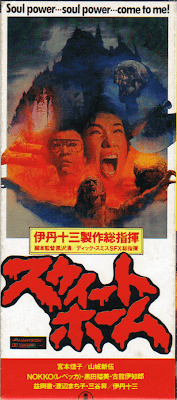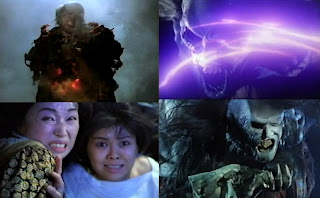This makes the re-discovery of Sweet Home all the more shocking. Released for the Famicom in December 1989, it broke the mold of traditional Dragon Quest-style RPGs in serving as Capcom’s first stab at survival horror and established a template for the first generation of Resident Evil titles.
The story follows a group of five reporters who visit the abandoned Mamiya mansion secluded deep in the wooded mountains to film a piece on the fresco paintings of the previous owner who died under mysterious causes thirty years prior. Our cast doesn’t even make it past the foyer before things go awry. Suddenly the rotted ceiling collapses seemingly of it’s own will, blocking the way out, and the vengeful spirit of Lady Mamiya appears to deliver a wicked portent—you will all die here!

The validity of her prophecy all depends on how the player manages their limited resources. Healing tonics are scattered few and far between about the manor grounds. Each character can only carry two items at a time in addition to their default tool, making inventory management a psychologically stressful task. Do you risk leaving recovery potions where they lay to keep your pockets empty for the key puzzle items supposedly coming up around the next turn? What’s your backup plan if the group carrying the candle is ambushed and needs support, but the other team has to fumble through the darkness to reach them?
Therein lies the defining feature of Sweet Home. The five characters can team up in groups of up to three, meaning that one team will always be a pair of hands short in exploration and combat, leading to tense moments where one party calls for the other mid-battle and the other races against the clock to save their friends from being butchered by the mansion’s supernatural inhabitants. Once a character dies, they (and their puzzle-solving tools) are gone for good. As the number of survivors dwindle you inch closer to a literal dead-end draws closer, making each enemy encounter a countdown to certain doom as your HP falls away into the void.
The immediacy of rushing in to help your teammates is only heightened by the frantic battle theme breathing down your neck as threatening as any ghoul or ghost. Like a good film, the soundtrack is another character in itself, covering the abstract pixellated mansion in a miasma of dread.

The cinematic qualities don’t end there. The birds-eye-view opening shot establishes the Mamiya manor as a desolate locale far removed from outside help—you are in this on your own. Unlock a door and we switch to a cut-scene of it creaking open, daring you to challenge the darkness within. There’s even pseudo-quick time actions where falling chandeliers and spike traps come flying at your POV, prompting you to make a quick dodge to safety or suffer the fatal consequences.

So far we have a creepy mansion, resource scarcity, pus-oozing monsters, door sequences—we're only missing one more of Resident Evil's hallmark features; Progressing the plot through diaries and letters left by their deceased authors. Sweet Home does this too with pages torn out of notebooks, dying messages writ in blood, and still cognizant corpses. As the party progresses through the house's puzzles, the gruesome truth behind the death of Lady Mamiya's baby and the local child kidnappings comes to light. The team will need to assemble the evidence of her terrible crimes in life to exorcise her spiteful spirit in death.
If the haunted aesthetic of the game was crafted by Fujiwara Tokuro, the Ghosts ‘n Goblins director and future general producer of Resident Evil, than we can assume that the cinematic flair was imbued by filmmaker Itami Juzo. Renowned for his satirical works like Tampopo and The Funeral, Itami had teamed up with Capcom and Fujiwara in the past to produce a Famicom adventure game adaptation of A Taxing Woman, his black comedy about a female IRS agent hounding the yakuza to come clean with their cooked books.
In fact, this wasn’t the first version of Sweet Home that Itami had produced either. He mentored a young Kurosawa Kiyoshi, director/screenwriter of the Sweet Home film that the game was faithfully based on. The tone of the movie is far removed from Kurosawa’s later slow-burning cerebral thrillers and feels more like a Hollywood haunted house flick, ironic considering that the gruesome special effects were handled by Poltergeist alumni Dick Smith.
Before his breakout hit with Cure, Kurosawa was stuck doing pink films like Kandagawa Pervert Wars for Nikkatsu. Through a lucky twist of fate, he met Itami on the set of The Excitement of the Do-Re-Mi-Fa Girl, a bawdy college sex romp where the seventy-year old actor played a lecherous professor who was very hands-on with his students. Itami took the promising director under his wing and showed him how to manufacture a hit in the industry—a bit too forcefully as it turned out.
The senior producer immediately wrested over creative control, bringing on Nokko, singer from the rock band Rebecca, for extra mainstream appeal, and, in typical Itami fashion, cast his wife Miyamoto Nobuko in the lead. He then proceeded to re-edit the movie without the director’s knowledge for the coup de grace. We’ll never know what Kurosawa’s vision of the film was—the final print shown in theaters and released on VHS is the Itami cut. As to be expected, the incident led to irreconcilable differences between the filmmakers, leaving the intellectual rights and possible remakes of the movie or game in legal limbo.
While the film drags a bit in the third act and the cast is worthless, its impressionistic use of shadows and eerie soundtrack make things bearable during the lengthy intermissions between special effect shots to keep the viewer from zoning out too much. If you're looking for more of a non-stop thrill ride, skip the movie and track down a translated version of the Famicom game. It delivers all the melting old man Itami-goodness you're itching for without the wait.







One thing that has always bothered me about Shinji Mikami's previous statements regarding the roots and inspirations of the original Resident Evil is that he only cites Sweet Home as a major influence.
ReplyDeleteI believe he has previously denied any inspirational umbilical cord connecting Alone in the Dark to that career defining hit of his.
The Sweet Home elements are undeniably there and prominent. But I wonder whether the more than uncanny resemblance to Alone in the Dark was the result of genuine convergent evolution or a simple case if inspiration denied by creator's pride or company mandate.
The team for the first Resident Evil was a Sweet Home class reunion so I have no doubt that Mikami drew many of his themes from it. With that said, there's too many similarities in the presentation between Alone in the Dark and Resident Evil to be a pure coincidence. I wouldn't say it was a rip-off as he took the title in different directions, but industry taboos will keep us from ever knowing the whole story.
ReplyDelete